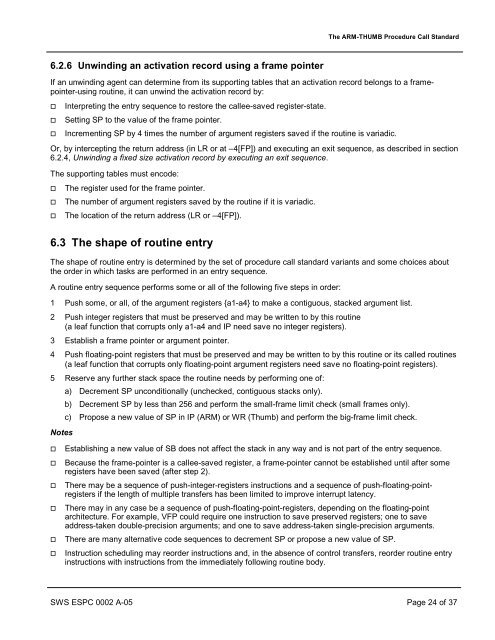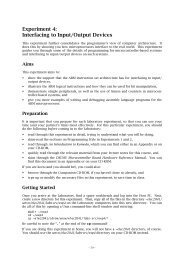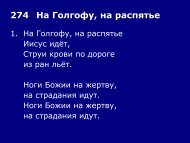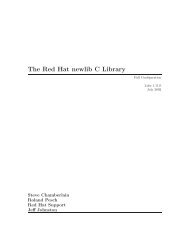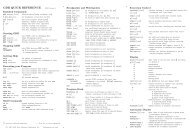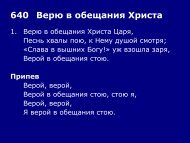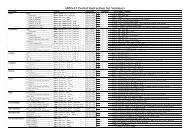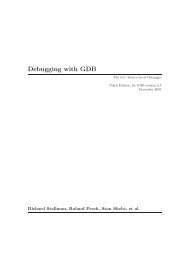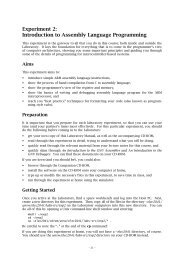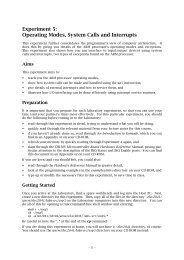The ARM-THUMB Procedure Call Standard
The ARM-THUMB Procedure Call Standard
The ARM-THUMB Procedure Call Standard
Create successful ePaper yourself
Turn your PDF publications into a flip-book with our unique Google optimized e-Paper software.
<strong>The</strong> <strong>ARM</strong>-<strong>THUMB</strong> <strong>Procedure</strong> <strong>Call</strong> <strong>Standard</strong>6.2.6 Unwinding an activation record using a frame pointerIf an unwinding agent can determine from its supporting tables that an activation record belongs to a framepointer-usingroutine, it can unwind the activation record by:oooInterpreting the entry sequence to restore the callee-saved register-state.Setting SP to the value of the frame pointer.Incrementing SP by 4 times the number of argument registers saved if the routine is variadic.Or, by intercepting the return address (in LR or at –4[FP]) and executing an exit sequence, as described in section6.2.4, Unwinding a fixed size activation record by executing an exit sequence.<strong>The</strong> supporting tables must encode:ooo<strong>The</strong> register used for the frame pointer.<strong>The</strong> number of argument registers saved by the routine if it is variadic.<strong>The</strong> location of the return address (LR or –4[FP]).6.3 <strong>The</strong> shape of routine entry<strong>The</strong> shape of routine entry is determined by the set of procedure call standard variants and some choices aboutthe order in which tasks are performed in an entry sequence.A routine entry sequence performs some or all of the following five steps in order:1 Push some, or all, of the argument registers {a1-a4} to make a contiguous, stacked argument list.2 Push integer registers that must be preserved and may be written to by this routine(a leaf function that corrupts only a1-a4 and IP need save no integer registers).3 Establish a frame pointer or argument pointer.4 Push floating-point registers that must be preserved and may be written to by this routine or its called routines(a leaf function that corrupts only floating-point argument registers need save no floating-point registers).5 Reserve any further stack space the routine needs by performing one of:Notesa) Decrement SP unconditionally (unchecked, contiguous stacks only).b) Decrement SP by less than 256 and perform the small-frame limit check (small frames only).c) Propose a new value of SP in IP (<strong>ARM</strong>) or WR (Thumb) and perform the big-frame limit check.ooooooEstablishing a new value of SB does not affect the stack in any way and is not part of the entry sequence.Because the frame-pointer is a callee-saved register, a frame-pointer cannot be established until after someregisters have been saved (after step 2).<strong>The</strong>re may be a sequence of push-integer-registers instructions and a sequence of push-floating-pointregistersif the length of multiple transfers has been limited to improve interrupt latency.<strong>The</strong>re may in any case be a sequence of push-floating-point-registers, depending on the floating-pointarchitecture. For example, VFP could require one instruction to save preserved registers; one to saveaddress-taken double-precision arguments; and one to save address-taken single-precision arguments.<strong>The</strong>re are many alternative code sequences to decrement SP or propose a new value of SP.Instruction scheduling may reorder instructions and, in the absence of control transfers, reorder routine entryinstructions with instructions from the immediately following routine body.SWS ESPC 0002 A-05 Page 24 of 37


